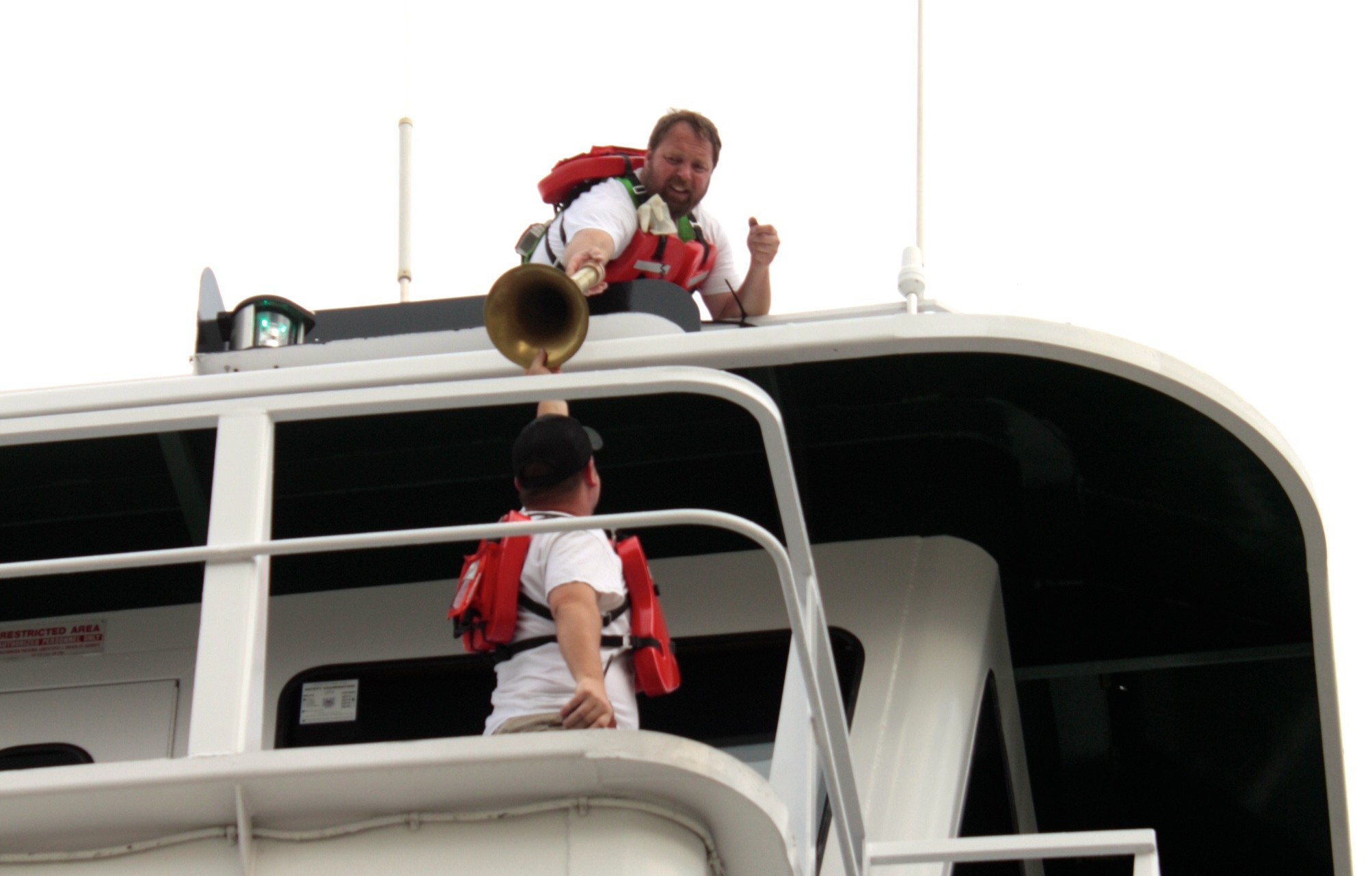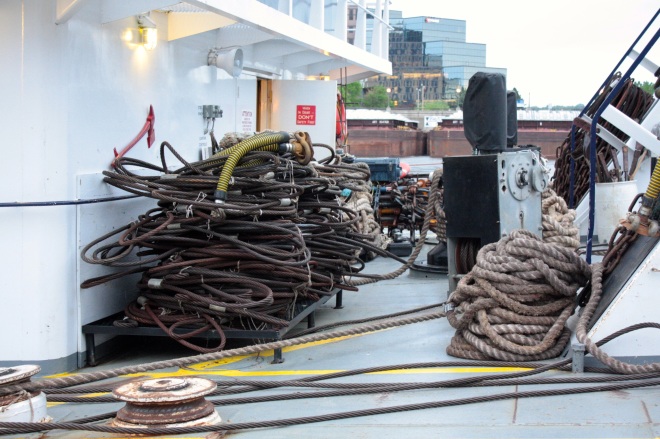May 27, 2014 West End, Lowertown, Downtown 13.5 miles

The Neil N. Diehl is tied up at Lambert’s Landing in Lowertown. The Robert Street bridge is in the background on the left and Downtown is to the right.
The saying “It’s not what you know, it’s who you know” is cliché but often true. Case in point is tonight’s ride to Lambert’s Landing in Lowertown. My friend, Rob Krause, has a brother who is a deckhand on the Mississippi River towboat the Neil N. Diehl. Rob told his brother Ken about my interest in talking to a towboat crew member and Ken mentioned it to his boat captain who agreed to meet for an interview on the vessel’s next trip to Saint Paul. That opportunity came on May 27th, a blustery, cool evening.

The author, standing on Lambert’s Landing, interviews Captain Darrel Lance aboard the Neil N. Diehl. Because of post-9-11 security, we were not allowed aboard the towboat.
Working on a river towboat is much more a lifestyle than a job. Darrel Lance, Captain of the Neil N. Diehl, and his crew work on the vessel day and night for 30 consecutive days. “We usually work 24 hours a day. Our watches are six hour watches. I work from 5 in the morning until 11. My pilot works from 11 to 5 in the afternoon. I come back on watch and work until 11 at night. The only time we stop is like repairs or pickin’ up barges and things like that.” Thirty days of pushing 15 or so barges that are 175 feet long, 26 feet wide, weighing about 1,600 tons each, up and down the Mississippi River are followed by 30 days off. Another captain and crew man the Neil N. Diehl during Captain Lance and company’s time off.
Shopping for groceries and supplies for nine folks living on a towboat for 30 days takes skillful planning and organization. “You got boat stores up and down the river. You just call ‘em and give ‘em a grocery order and they got it whenever you get there.” Then the food is brought out on a skiff to the towboat. Among the cities with boat stores are Saint Paul, Winona, Belleview and Burlington, Iowa. Most meals are the cook’s choice, “Yeah, the cook does most of it,” said Captain Lance. “If some of my crew members want somethin’ separate, they’ll tell her. She tries to accommodate some of us. Like right now, I’m on a diet. She’s been boiling me chicken and everything else. I lost 21 pounds in six weeks.”
The Neil N. Diehl usually runs with nine crew members, including Captain Lance, a pilot, an engineer, a cook, (the lone woman aboard) deckhands, and mates. “Everybody has a job. And you work as a team but you live out here so much with all these other people it becomes like a second family to you.” Captain Lance added, “You really gotta wanna work at it. It’s good money; you’re gone from your family a lot but it’s a good living, especially if you get with a good company.”
“You gotta’ wanna be here ‘cause if you don’t wanna’ be here, it’s really miserable.”
Captain Lance began his nautical career with a stint in the military 30 years ago, “I started out in navigation in the gulf and I’m ex-Navy. I worked on a seismograph off the shore first, then I went to tugs and then I started decking, learned the deck department, and 18 months later I was in the pilot house ‘cause I knew I wasn’t going to stay out there swinging ratchets all my life.” Ratchets are large tools used to tighten the cables that keep barges attached to each other and the boat.“
“You don’t have to just go in the wheelhouse; you can go in the engine room, cook, stay at a mate. Some mates out here make almost as much as a pilot does. And it’s good retirement.”
Today, landing a job on any Ingram Company towboat starts with an online job application. A promising application earns the applicant a telephone interview, followed by an in-person interview. A training program is next for those hired. According to the captain, “They have you in a training process in Paducah (Kentucky) for a week; bring you down there, get another drug screening and they put you through seven days of pretty good work. Heavy liftin’, stuff like that. It’s pretty rigorous down there and then they put ‘em on the boat for seven days. It’s called seven day on-board training and that’s when you keep ‘em or kick ‘em out. I’d say 80 percent of ‘em make it.”
When a new crew member is placed on a towboat, Lance said he or she is watched carefully. “They stay in the mate’s back pocket. They learn how to splice lines, splice wires, carry wires, lay rigging, ratchet technician, tightening wires and stuff.”
“If they don’t know how to clean their own house, they will when they get off that boat. They’ll know how to clean their walls, their floors, everything because we keep a very clean vessel.”
It’s not all physical labor, at least for the captain and pilot. Technology is commonplace in the wheelhouse, “When I get on board, I have to go online to the computer and it tells me what we have to do this trip, be it man overboard drills or what kind of drills the Coast Guard requires, meetings we have to have, vessel security, stuff like that. “Our company sends us an email, boat orders, and it says on there ‘pick up nine (barges) out of here, we gotta pick up three down here and three down there and three down there and so on down the river until we fill out 15.” (Fifteen barges, said Captain Lance, are the most a towboat is allowed to push in either direction between Saint Paul and St. Louis.)
The Neil N. Diehl ordinarily runs barges between Saint Paul and Cairo, Illinois (pronounced KAY-roh or CARE-roh, it is the southernmost city in Illinois). The barges are filled with corn and occasionally beans leaving Saint Paul, while northbound cargo is almost always concrete.

Towboat is a misnomer because the Neil N. Diehl and similar vessels push the barges up and down the river.
Towboats and their crews are subject to some unusual hazards. “Up here (the upper Mississippi),” Captain Lance told me, “we pretty much just watch current and pleasure boats because pleasure boats get in your way a lot. When we run over one we have to defend ourselves. We’re guilty until proven innocent.”
Then there are the mayflies, “Those things-they stink, boy. Sometimes you’ll be goin’ down the river and they’ll blank the radar out, they’re so thick. And if you got any wood on the outside, like your nameboards are wood, next morning they’ll be nothin’ but mayflies stickin’ to ‘em. I don’t know what it is about lacquer but they love that lacquer. They get so thick sometimes you gotta get on top of the pilot house with a shovel when you use these search lights and just shovel it off.”

Towboats usually dock at Lambert’s Landing when in Saint Paul. Downtown is on the right and the Robert Street Bridge is on the left.
Captain Lance’s most memorable day on the job came about early in his career, when he was on one of two boats working a dredge in the New Orleans harbor. “I was on the Miss Sarah. The Captain Vic went out there and was gonna hold the pipeline up while I tripped the anchor and let it fall. Well the anchor wouldn’t trip… I got in the current and it got above my stern, busted in my engine room door and it sunk.” Fortunately Lance and the other crew member on the Miss Sarah got out safely, but they bobbed in the Mississippi River for about three miles before being pulled out. The Miss Sarah didn’t fare as well – she’s still sitting on the bottom of the harbor in about 300 feet of water.
A side note to the sinking of the Miss Sarah involved a bunch of flashing lights on the vessel, very much like those on barricades. Captain Lance explained it this way, “We just put new batteries in ‘em. So that night, man, it was lit up all down in the harbor. They were floating underneath the docks and everything. Yeah, it was pretty neat.”
Where does Captain Lance spend much of his time when he’s away from the Neil N. Diehl after a 30 day shift? “Fishin’. I do a lot of salt water fishin’. And travelin’. We do a lot of cruise travel, my family; me and my wife and her sister and brother-in-law.” I said it’s funny that he likes going on cruises. “Well, I can have a beer on a cruise. I can’t have one here.” And he laughed. “I get my license taken away from me here.” When ice closes the upper Mississippi to shipping, the Neil N. Diehl either operates on the Ohio and Illinois rivers or is docked.





